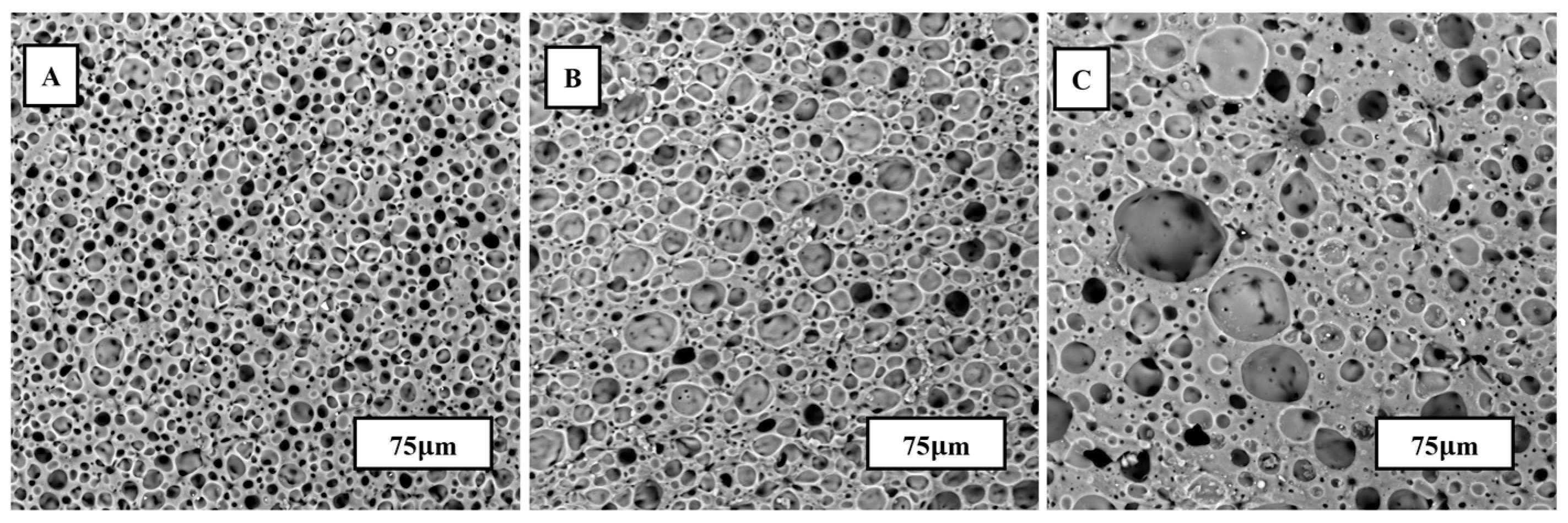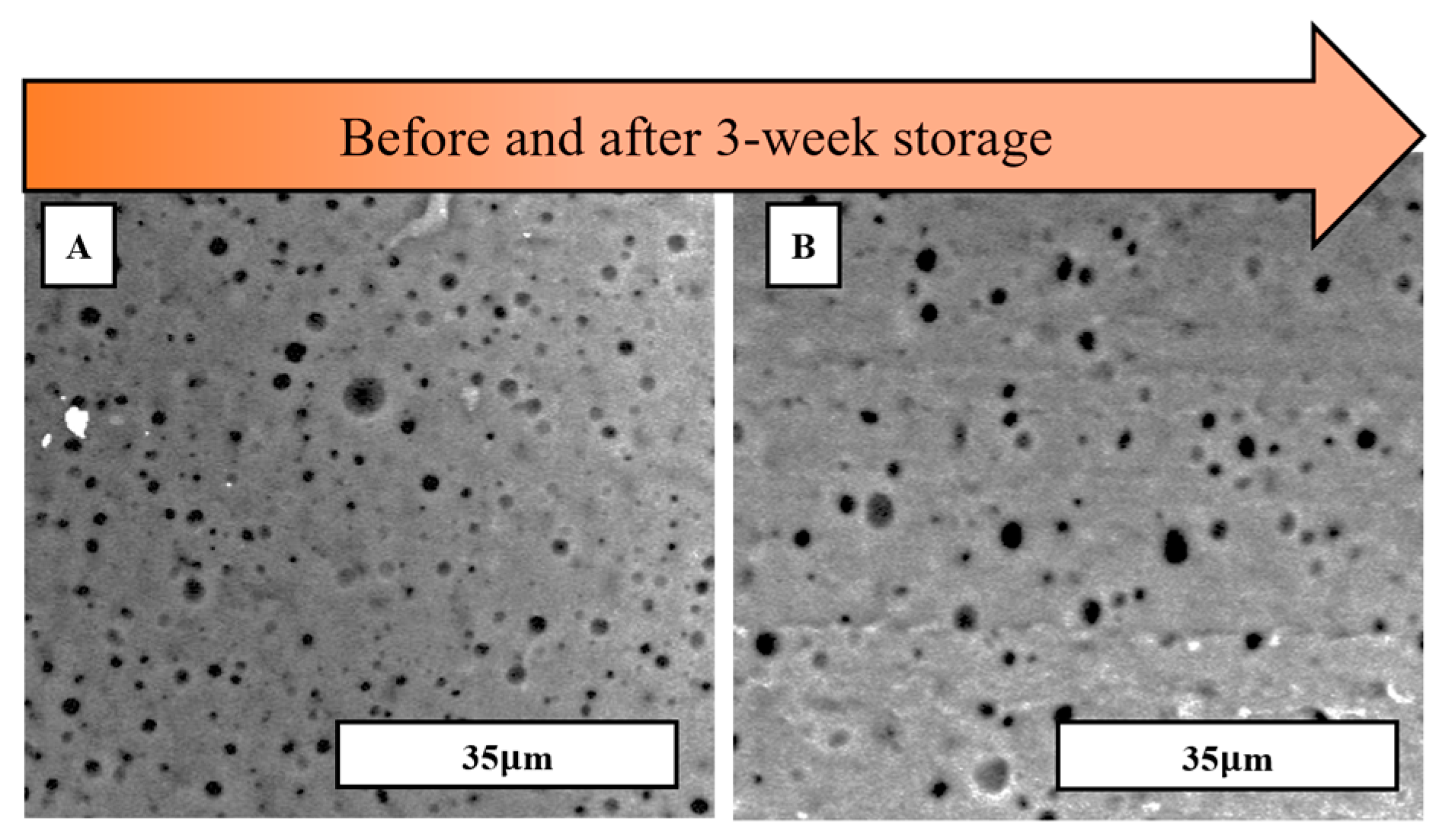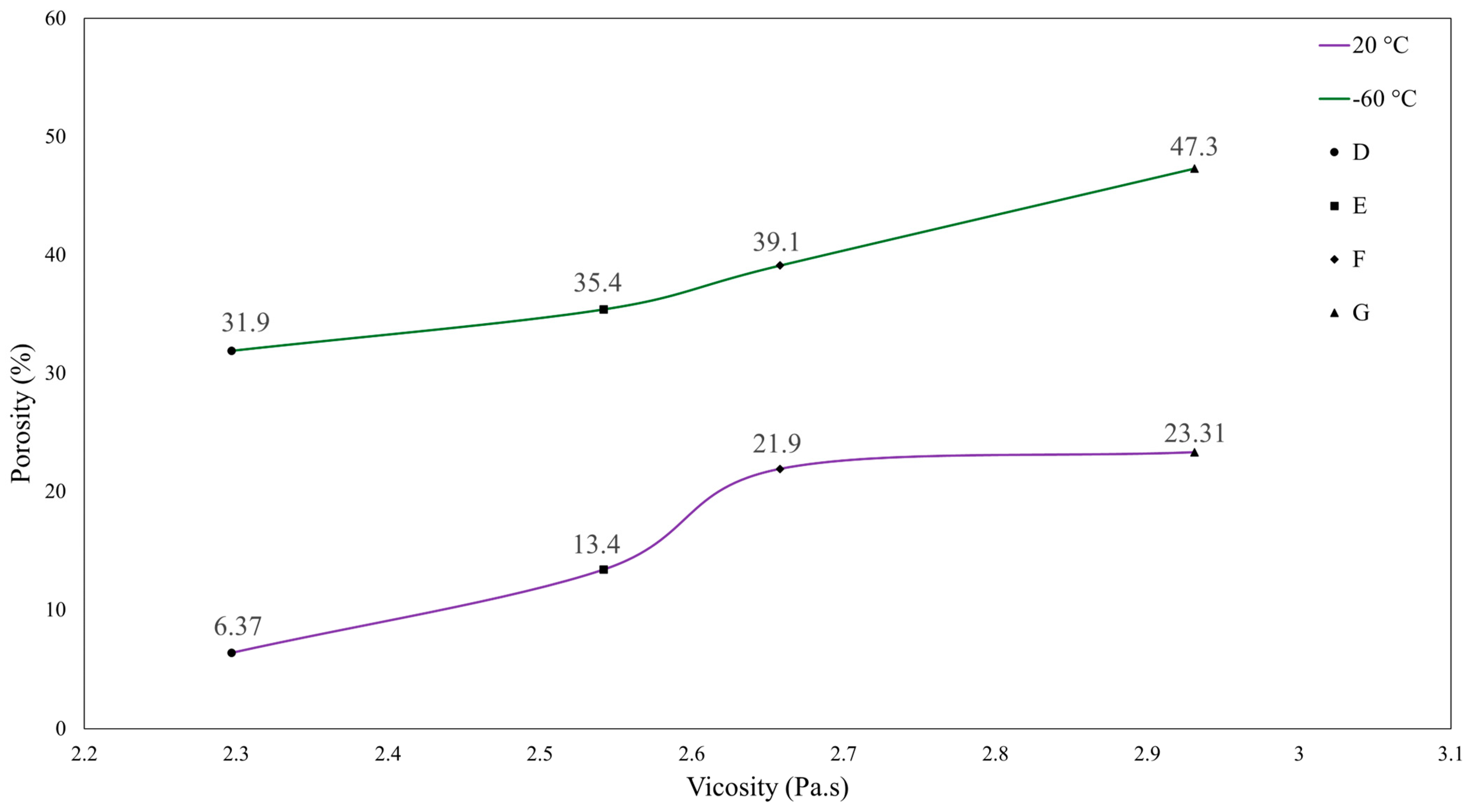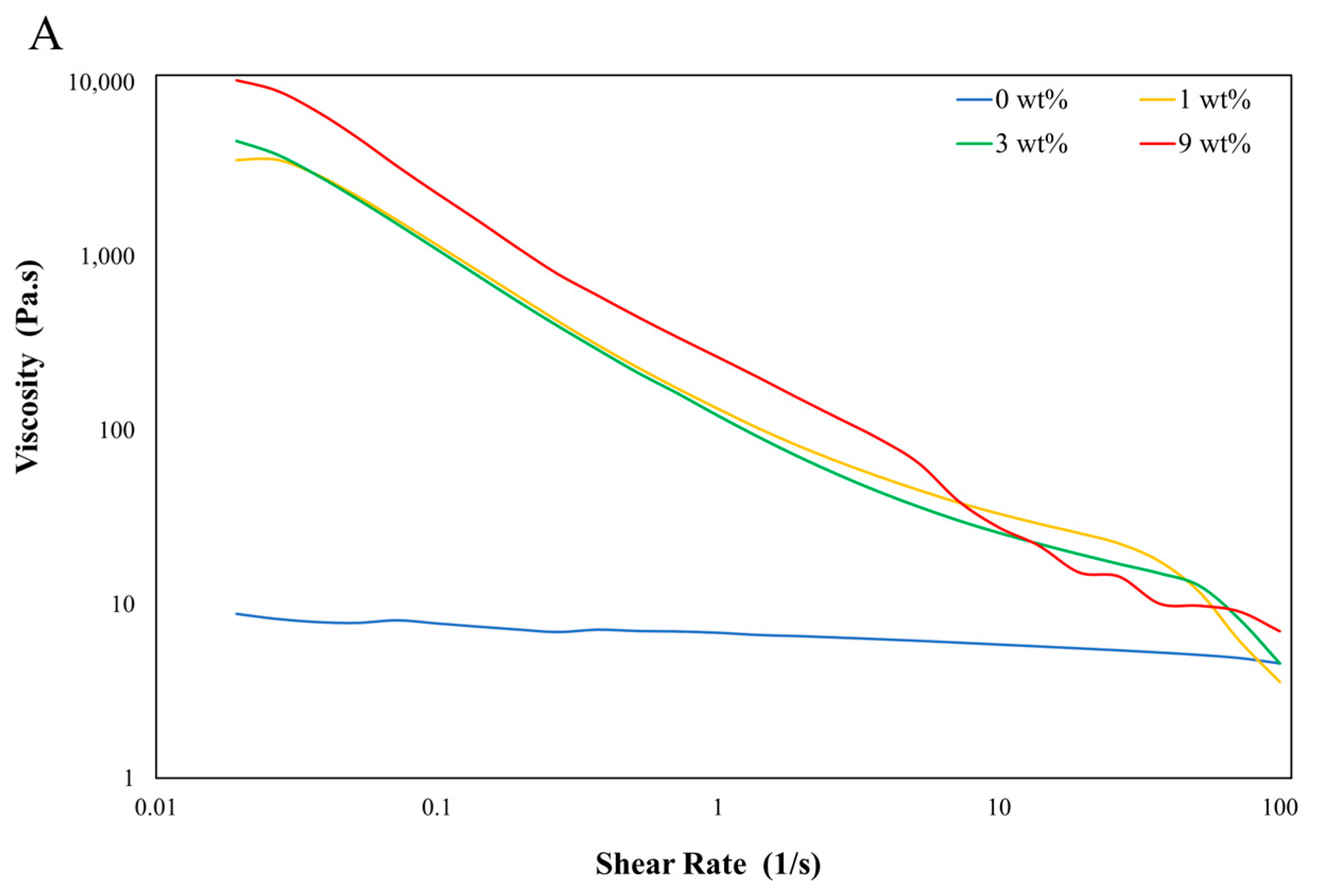Porous Polymer Structures with Tunable Mechanical Properties Using a Water Emulsion Ink
Abstract
1. Introduction
2. Materials and Methods
2.1. Materials
2.2. Formulation of Water Emulsion Foams with Varying Water Percentages
2.3. Preparation of Water Emulsion Foams with Varying PDMS Viscosities
2.4. Preparation of Water Emulsion Ink for DIW
2.5. Characterization
3. Results and Discussion
3.1. Microstructure Characterization and Porosity
3.2. Uniaxial Compression Testing of Water Emulsion Foams
3.3. Storage Life Assessment of Water Emulsion Foams
3.4. Exploration of Storage Procedure
3.5. Rheological Properties of Water Emulsion Foams
4. Conclusions
Author Contributions
Funding
Institutional Review Board Statement
Informed Consent Statement
Data Availability Statement
Conflicts of Interest
References
- Day, G.S.; Drake, H.F.; Zhou, H.C.; Ryder, M.R. Evolution of porous materials from ancient remedies to modern frameworks. Commun. Chem. 2021, 4, 114. [Google Scholar] [CrossRef]
- Wu, D.; Xu, F.; Sun, B.; Fu, R.; He, H.; Matyjaszewski, K. Design and preparation of porous polymers. Chem. Rev. 2012, 112, 3959–4015. [Google Scholar] [CrossRef]
- Liu, F.; Yi, B.; Xing, D.; Yu, J.; Zhang, H. Nafion/PTFE composite membranes for fuel cell applications. J. Membr. Sci. 2003, 212, 213–223. [Google Scholar] [CrossRef]
- Paljevac, M.; Gradišnik, L.; Lipovšek, S.; Maver, U.; Kotek, J.; Krajnc, P. Multiple-Level Porous Polymer Monoliths with Interconnected Cellular Topology Prepared by Combining Hard Sphere and Emulsion Templating for Use in Bone Tissue Engineering. Macromol. Biosci. 2018, 18, 1700306. [Google Scholar] [CrossRef]
- Kim, S.; Park, M.S.; Gwak, S.; Choi, Y.C.; Kim, B. Accelerated Bonelike Apatite Growth on Porous PolymerCeramic Composite Scaffolds in Vitro. Tissue Eng. 2006, 12, 2997–3006. [Google Scholar] [CrossRef] [PubMed]
- Das, A.; Deka, J.; Rather, A.M.; Bhunia, B.K.; Saikia, P.P.; Mandal, B.B.; Raidongia, K.; Manna, U. Strategic Formulation of Graphene Oxide Sheets for Flexible Monoliths and Robust Polymeric Coatings Embedded with Durable Bioinspired Wettability. ACS Appl. Mater. Interfaces 2017, 9, 42354–42365. [Google Scholar] [CrossRef]
- Das, A.; Deka, J.; Raidongia, K.; Manna, U. Robust and Self-Healable Bulk-Superhydrophobic Polymeric Coating. Chem. Mater. 2017, 29, 8720–8728. [Google Scholar] [CrossRef]
- Yeo, W.; Kim, Y.; Lee, J.; Ameen, A.; Shi, L.; Li, M.; Wang, S.; Ma, R.; Jin, S.H.; Kang, Z.; et al. Multifunctional epidermal electronics printed directly onto the skin. Adv. Mater. 2013, 25, 2773–2778. [Google Scholar] [CrossRef] [PubMed]
- Kim, S.H.; Moon, J.H.; Kim, J.H.; Jeong, S.M.; Lee, S.H. Flexible, stretchable and implantable PDMS encapsulated cable for implantable medical device. Biomed. Eng. Lett. 2011, 1, 199–203. [Google Scholar] [CrossRef]
- Chen, Y.; Zhou, X.; Huang, S.; Lan, Y.; Yan, R.; Shi, X.; Li, X.; Zhang, Y.; Lei, Z.; Fan, D. Effect of Microgroove Structure in PDMS-Based Silicone Implants on Biocompatibility. Front. Bioeng. Biotechnol. 2022, 9, 793778. [Google Scholar] [CrossRef]
- Yoo, B.Y.; Kim, B.H.; Lee, J.S.; Shin, B.H.; Kwon, H.; Koh, W.-G.; Heo, C.Y. Dual surface modification of PDMS-based silicone implants to suppress capsular contracture. Acta Biomater. 2018, 76, 56–70. [Google Scholar] [CrossRef] [PubMed]
- Miranda, I.; Souza, A.; Sousa, P.; Ribeiro, J.; Castanheira, E.M.S.; Lima, R.; Minas, G. Properties and applications of PDMS for biomedical engineering: A review. J. Funct. Biomater. 2022, 13, 2. [Google Scholar] [CrossRef] [PubMed]
- Bragheri, F.; Vázquez, R.M.; Osellame, R. Microfluidics. In Three-Dimensional Microfabrication Using Two-Photon Polymerization; Elsevier: Amsterdam, The Netherlands, 2019; pp. 493–526. [Google Scholar] [CrossRef]
- Kang, S.; Lee, J.; Lee, S.; Kim, S.; Kim, J.; Algadi, H.; Al-Sayari, S.; Kim, D.; Lee, T. Highly Sensitive Pressure Sensor Based on Bioinspired Porous Structure for Real-Time Tactile Sensing. Adv. Electron. Mater. 2016, 2, 1600356. [Google Scholar] [CrossRef]
- Mikolaszek, B.; Kazlauske, J.; Larsson, A.; Sznitowska, M. Controlled drug release by the pore structure in polydimethylsiloxane transdermal patches. Polymers 2020, 12, 1520. [Google Scholar] [CrossRef] [PubMed]
- Guo, N.; Leu, M.C. Additive manufacturing: Technology, applications and research needs. Front. Mech. Eng. 2013, 8, 215–243. [Google Scholar] [CrossRef]
- Park, S.I.; Rosen, D.W.; Choi, S.K.; Duty, C.E. Effective mechanical properties of lattice material fabricated by material extrusion additive manufacturing. Addit. Manuf. 2014, 1, 12–23. [Google Scholar] [CrossRef]
- Marquez, C.; Mata, J.J.; Renteria, A.; Gonzalez, D.; Gomez, S.G.; Lopez, A.; Baca, A.N.; Nuñez, A.; Hassan, S.; Burke, V.; et al. Direct Ink-Write Printing of Ceramic Clay with an Embedded Wireless Temperature and Relative Humidity Sensor. Sensors 2023, 23, 3352. [Google Scholar] [CrossRef]
- Rocha, V.G.; Saiz, E.; Tirichenko, I.S.; García-Tuñón, E. Direct ink writing advances in multi-material structures for a sustainable future. J. Mater. Chem. A 2020, 8, 15646–15657. [Google Scholar] [CrossRef]
- Yan, J.; Huang, S.; Von Lim, Y.; Xu, T.; Kong, D.; Li, X.; Yang, H.Y.; Wang, Y. Direct-ink writing 3D printed energy storage devices: From material selectivity, design and optimization strategies to diverse applications. Mater. Today 2022, 54, 110–152. [Google Scholar] [CrossRef]
- Ozbolat, V.; Dey, M.; Ayan, B.; Povilianskas, A.; Demirel, M.C.; Ozbolat, I.T. 3D Printing of PDMS Improves Its Mechanical and Cell Adhesion Properties. ACS Biomater. Sci. Eng. 2018, 4, 682–693. [Google Scholar] [CrossRef]
- Femmer, T.; Kuehne, A.J.C.; Wessling, M. Print your own membrane: Direct rapid prototyping of polydimethylsiloxane. Lab Chip 2014, 14, 2610–2613. [Google Scholar] [CrossRef] [PubMed]
- Chen, Q.; Zhao, J.; Ren, J.; Rong, L.; Cao, P.; Advincula, R.C. 3D Printed Multifunctional, Hyperelastic Silicone Rubber Foam. Adv. Funct. Mater. 2019, 29, 1900469. [Google Scholar] [CrossRef]
- Woo, R.; Chen, G.; Zhao, J.; Bae, J. Structure-Mechanical Property Relationships of 3D-Printed Porous Polydimethylsiloxane. ACS Appl. Polym. Mater. 2021, 3, 3496–3503. [Google Scholar] [CrossRef]
- Oyama, T.G.; Oyama, K.; Taguchi, M. A simple method for production of hydrophilic, rigid, and sterilized multi-layer 3D integrated polydimethylsiloxane microfluidic chips. Lab Chip 2020, 20, 2354–2363. [Google Scholar] [CrossRef]
- Wang, X.; Li, J.; Song, H.; Huang, H.; Gou, J. Highly Stretchable and Wearable Strain Sensor Based on Printable Carbon Nanotube Layers/Polydimethylsiloxane Composites with Adjustable Sensitivity. ACS Appl. Mater. Interfaces 2018, 10, 7371–7380. [Google Scholar] [CrossRef] [PubMed]
- ASTM D575-91; Standard Test Methods for Rubber Properties in Compression. ASTM International: West Conshohocken, PA, USA, 2018. [CrossRef]
- Shang, E.; Li, G.; Zhao, Z.; Zhang, N.; Fan, D.; Liu, Y. Laser-Assisted Direct Ink Writing for High-Fidelity Fabrication of Elastomeric Complex Structures. Adv. Mater. Interfaces 2023, 10, 2300300. [Google Scholar] [CrossRef]
- Zhang, B.; Zhang, P.; Zhang, H.; Yan, C.; Zheng, Z.; Wu, B.; Yu, Y. A Transparent, Highly Stretchable, Autonomous Self-Healing Poly(dimethyl siloxane) Elastomer. Macromol. Rapid Commun. 2017, 38, 1700110. [Google Scholar] [CrossRef] [PubMed]
- Mohammed, A.; Abdullah, A. Scanning Electron Microscopy (SEM): A REVIEW. In Proceedings of the 2018 International Conference on Hydraulics and Pneumatics-HERVEX, Băile Govora, Romania, 7–9 November 2018; pp. 77–82. [Google Scholar]
- Nesterenko, A.; Drelich, A.; Lu, H.; Clausse, D.; Pezron, I. Influence of a mixed particle/surfactant emulsifier system on water-in-oil emulsion stability. Colloids Surf. A Physicochem. Eng. Asp. 2014, 457, 49–57. [Google Scholar] [CrossRef]
- Zhao, J.; Lin, Y.; Chang, J.; Lu, A.; Chen, W.; Meng, L.; Wang, D.; Li, L. Stretch-Induced Crystallization and Phase Transitions of Poly(dimethylsiloxane) at Low Temperatures: An in Situ Synchrotron Radiation Wide-Angle X-ray Scattering Study. Macromolecules 2018, 51, 8424–8434. [Google Scholar] [CrossRef]
- Ushikubo, F.Y.; Cunha, R.L. Stability mechanisms of liquid water-in-oil emulsions. Food Hydrocoll. 2014, 34, 145–153. [Google Scholar] [CrossRef]
- Corker, A.; Ng, H.C.H.; Poole, R.J.; García-Tuñón, E. 3D printing with 2D colloids: Designing rheology protocols to predict ‘printability’ of soft-materials. Soft Matter 2019, 15, 1444–1456. [Google Scholar] [CrossRef]
- Cipriani, C.E.; Ha, T.; Defilló, O.B.M.; Myneni, M.; Wang, Y.; Benjamin, C.C.; Wang, J.; Pentzer, E.B.; Wei, P. Structure-Processing-Property Relationships of 3D Printed Porous Polymeric Materials. ACS Mater. Au 2021, 1, 69–80. [Google Scholar] [CrossRef]
- Paquien, J.N.; Galy, J.; Gérard, J.F.; Pouchelon, A. Rheological studies of fumed silica-polydimethylsiloxane suspensions. Colloids Surf. A Physicochem. Eng. Asp. 2005, 260, 165–172. [Google Scholar] [CrossRef]
- Gutierrez, D.B.; Caldona, E.B.; Yang, Z.; Suo, X.; Cheng, X.; Dai, S.; Espiritu, R.D.; Advincula, R.C. 3D-printed PDMS-based membranes for CO2 separation applications. MRS Commun. 2022, 12, 1174–1182. [Google Scholar] [CrossRef]
- Qin, S.; Jiang, Y.; Ji, Z.; Yang, C.; Guo, Y.; Zhang, X.; Qin, H.; Jia, X.; Wang, X. Three-dimensional printing of high-performance polyimide by direct ink writing of hydrogel precursor. J. Appl. Polym. Sci. 2021, 138, 50636. [Google Scholar] [CrossRef]
- Rau, D.A.; Williams, C.B.; Bortner, M.J. Rheology and printability: A survey of critical relationships for direct ink write materials design. Prog. Mater. Sci. 2023, 140, 101188. [Google Scholar] [CrossRef]
- Montazerian, H.; Mohamed, M.; Montazeri, M.M.; Kheiri, S.; Milani, A.; Kim, K.; Hoorfar, M. Permeability and mechanical properties of gradient porous PDMS scaffolds fabricated by 3D-printed sacrificial templates designed with minimal surfaces. Acta Biomater. 2019, 96, 149–160. [Google Scholar] [CrossRef] [PubMed]
- Chen, H.; Zhang, W.M.; Li, X.; Ding, Q.; Shao, L. Direct Ink Writing of Pure PDMS for Soft 3D Microstructures and Tactile Sensors. In Proceedings of the 21st International Conference on Solid-State Sensors, Actuators and Microsystems, TRANSDUCERS 2021, Orlando, FL, USA, 20–24 June 2021; Institute of Electrical and Electronics Engineers (IEEE): New York, NY, USA, 2021; pp. 525–528. [Google Scholar] [CrossRef]
- Dardouri, M.; Bettencourt, A.; Martin, V.; Carvalho, F.A.; Colaço, B.; Gama, A.; Ramstedt, M.; Santos, N.C.; Fernandes, M.H.; Gomes, P.S.; et al. Assuring the Biofunctionalization of Silicone Covalently Bonded to Rhamnolipids: Antibiofilm Activity and Biocompatibility. Pharmaceutics 2022, 14, 1836. [Google Scholar] [CrossRef] [PubMed]
- Stepulane, A.; Rajasekharan, A.K.; Andersson, M. Multifunctional Surface Modification of PDMS for Antibacterial Contact Killing and Drug-Delivery of Polar, Nonpolar, and Amphiphilic Drugs. ACS Appl. Bio Mater. 2022, 5, 5289–5301. [Google Scholar] [CrossRef] [PubMed]
- Sutthiwanjampa, C.; Shin, B.H.; Ryu, N.E.; Kang, S.H.; Heo, C.Y.; Park, H. Assessment of human adipose-derived stem cell on surface-modified silicone implant to reduce capsular contracture formation. Bioeng. Transl. Med. 2022, 7, e10260. [Google Scholar] [CrossRef]
- Fischer, H.R.; Tempelaars, K.; Kerpershoek, A.; Dingemans, T.; Iqbal, M.; van Lonkhuyzen, H.; Iwanowsky, B.; Semprimoschnig, C. Development of flexible LEO-resistant PI films for space applications using a self-healing mechanism by surface-directed phase separation of block copolymers. ACS Appl. Mater. Interfaces 2010, 2, 2218–2225. [Google Scholar] [CrossRef] [PubMed]
- Zhang, Y.; Karasu, F.; Rocco, C.; van der Ven, L.; van Benthem, R.; Allonas, X.; Croutxé-Barghorn, C.; Esteves, A.; de With, G. PDMS-based self-replenishing coatings. Polymer 2016, 107, 249–262. [Google Scholar] [CrossRef]
- Bora, P.J.; Jois, M.H.; Ramamurthy, P.C. PDMS-Ni coated flyash cenosphere composite for broadband microwave absorption. In Proceedings of the 4th IEEE International Conference on Emerging Electronics (ICEE), Bengaluru, India, 17–19 December 2018; Institute of Electrical and Electronics Engineers (IEEE): Bengaluru, India, 2018. [Google Scholar] [CrossRef]










| Specimen | PDMS/Water Ratio (wt%) | Average Pore Diameter (µm) | Average Porosity (%) |
|---|---|---|---|
| Z (Bulk) | 100:0 | 0.00 | 0.00 |
| A | 65:35 | 4.22 | 30.2 |
| B | 35:65 | 4.91 | 55.5 |
| C | 10:90 | 5.35 | 51.9 |
| Specimen | Modulus of Elasticity (MPa) | Energy Absorption (J/mm3) | Compressive Strength (MPa) |
|---|---|---|---|
| Z (Bulk) | 0.89 | 0.15 | 1.20 |
| A | 1.17 | 0.33 | 3.50 |
| B | 0.40 | 0.11 | 1.63 |
| C | 0.73 | 0.13 | 1.23 |
| Specimen | Sylgard 184:Dowsil 1700 (wt%) | PDMS/Water (wt%) | Average Pore Diameter (µm) | Porosity (%) | Experimental Viscosity (Pa·s) |
|---|---|---|---|---|---|
| A | 100:0 | 65:35 | 6.48 | 30.2 | 2.013 |
| D | 90:10 | 65:35 | 5.47 | 20.4 | 2.297 |
| E | 80:20 | 65:35 | 4.22 | 18.2 | 2.542 |
| F | 70:30 | 65:35 | 2.86 | 9.4 | 2.658 |
| G | 60:40 | 65:35 | 2.01 | 9.2 | 2.931 |
| Trial # | Sylgard 184:Dowsil 1700 (wt%) | PDMS/Water (wt%) | Fumed Silica Particles (wt%) | Experimental Viscosity (Pa·s) |
|---|---|---|---|---|
| 1 | 30:70 | 65:35 | 0 | 8.8 |
| 2 | 50:50 | 65:35 | 1 | 3583.1 |
| 3 | 40:60 | 65:35 | 3 | 4612.7 |
| 4 | 70:30 | 65:35 | 9 | 10,290.8 |
Disclaimer/Publisher’s Note: The statements, opinions and data contained in all publications are solely those of the individual author(s) and contributor(s) and not of MDPI and/or the editor(s). MDPI and/or the editor(s) disclaim responsibility for any injury to people or property resulting from any ideas, methods, instructions or products referred to in the content. |
© 2024 by the authors. Licensee MDPI, Basel, Switzerland. This article is an open access article distributed under the terms and conditions of the Creative Commons Attribution (CC BY) license (https://creativecommons.org/licenses/by/4.0/).
Share and Cite
Dantzler, J.Z.R.; Gomez, S.G.; Gonzalez, S.; Gonzalez, D.; Loera Martinez, A.O.; Marquez, C.; Hassan, M.S.; Zaman, S.; Lopez, A.; Mahmud, M.S.; et al. Porous Polymer Structures with Tunable Mechanical Properties Using a Water Emulsion Ink. Materials 2024, 17, 1074. https://doi.org/10.3390/ma17051074
Dantzler JZR, Gomez SG, Gonzalez S, Gonzalez D, Loera Martinez AO, Marquez C, Hassan MS, Zaman S, Lopez A, Mahmud MS, et al. Porous Polymer Structures with Tunable Mechanical Properties Using a Water Emulsion Ink. Materials. 2024; 17(5):1074. https://doi.org/10.3390/ma17051074
Chicago/Turabian StyleDantzler, Joshua Z. R., Sofia Gabriela Gomez, Stephanie Gonzalez, Diego Gonzalez, Alan O. Loera Martinez, Cory Marquez, Md Sahid Hassan, Saqlain Zaman, Alexis Lopez, Md Shahjahan Mahmud, and et al. 2024. "Porous Polymer Structures with Tunable Mechanical Properties Using a Water Emulsion Ink" Materials 17, no. 5: 1074. https://doi.org/10.3390/ma17051074
APA StyleDantzler, J. Z. R., Gomez, S. G., Gonzalez, S., Gonzalez, D., Loera Martinez, A. O., Marquez, C., Hassan, M. S., Zaman, S., Lopez, A., Mahmud, M. S., & Lin, Y. (2024). Porous Polymer Structures with Tunable Mechanical Properties Using a Water Emulsion Ink. Materials, 17(5), 1074. https://doi.org/10.3390/ma17051074









